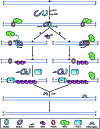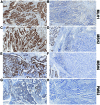Deficient mismatch repair: Read all about it (Review)
- PMID: 26315971
- PMCID: PMC4583524
- DOI: 10.3892/ijo.2015.3119
Deficient mismatch repair: Read all about it (Review)
Abstract
Defects in the DNA mismatch repair (MMR) proteins, result in a phenotype called microsatellite instability (MSI), occurring in up to 15% of sporadic colorectal cancers. Approximately one quarter of colon cancers with deficient MMR (dMMR) develop as a result of an inherited predisposition syndrome, Lynch syndrome (formerly known as HNPCC). It is essential to identify patients who potentially have Lynch syndrome, as not only they, but also family members, may require screening and monitoring. Diagnostic criteria have been developed, based primarily on Western populations, and several methodologies are available to identify dMMR tumours, including immunohistochemistry and microsatellite testing. These criteria have provided evidence supporting the introduction of reflex testing. Yet, it is becoming increasingly clear that tests have a limited sensitivity and specificity and may yet be superseded by next generation sequencing. In this review, the limitations of diagnostic criteria are discussed, and current and emerging screening technologies explained. There is now useful evidence supporting the prognostic and predictive value of dMMR status in colorectal tumours, but much less is known about their value in extracolonic tumours, that may also feature in Lynch syndrome. This review assesses current literature relating to dMMR in endometrial, ovarian, gastric and melanoma cancers, which it would seem, may benefit from large-scale clinical trials in order to further close the gap in knowledge between colorectal and extracolonic tumours.
Figures


References
-
- Sinicrope FA, Rego RL, Foster N, Sargent DJ, Windschitl HE, Burgart LJ, Witzig TE, Thibodeau SN. Microsatellite instability accounts for tumor site-related differences in clinicopathologic variables and prognosis in human colon cancers. Am J Gastroenterol. 2006;101:2818–2825. doi: 10.1111/j.1572-0241.2006.00845.x. - DOI - PubMed
-
- Thibodeau SN, French AJ, Cunningham JM, Tester D, Burgart LJ, Roche PC, McDonnell SK, Schaid DJ, Vockley CW, Michels VV, et al. Microsatellite instability in colorectal cancer: Different mutator phenotypes and the principal involvement of hMLH1. Cancer Res. 1998;58:1713–1718. - PubMed
Publication types
MeSH terms
LinkOut - more resources
Full Text Sources
Other Literature Sources
Miscellaneous

